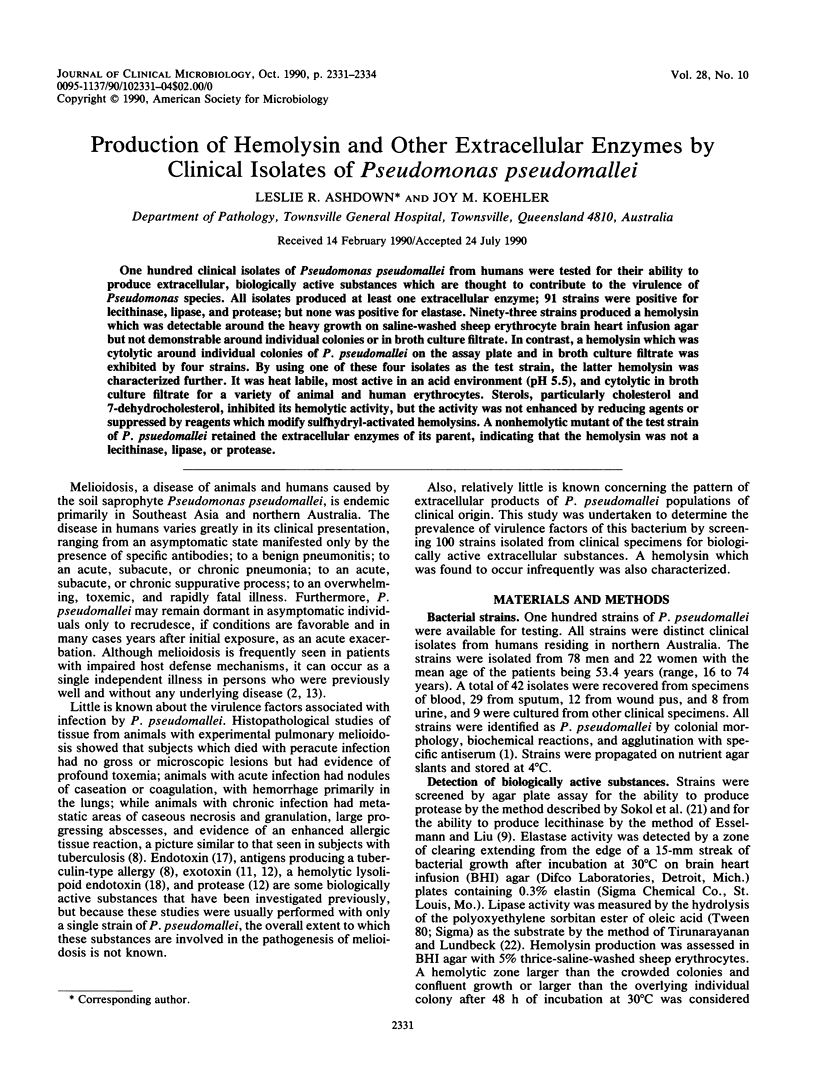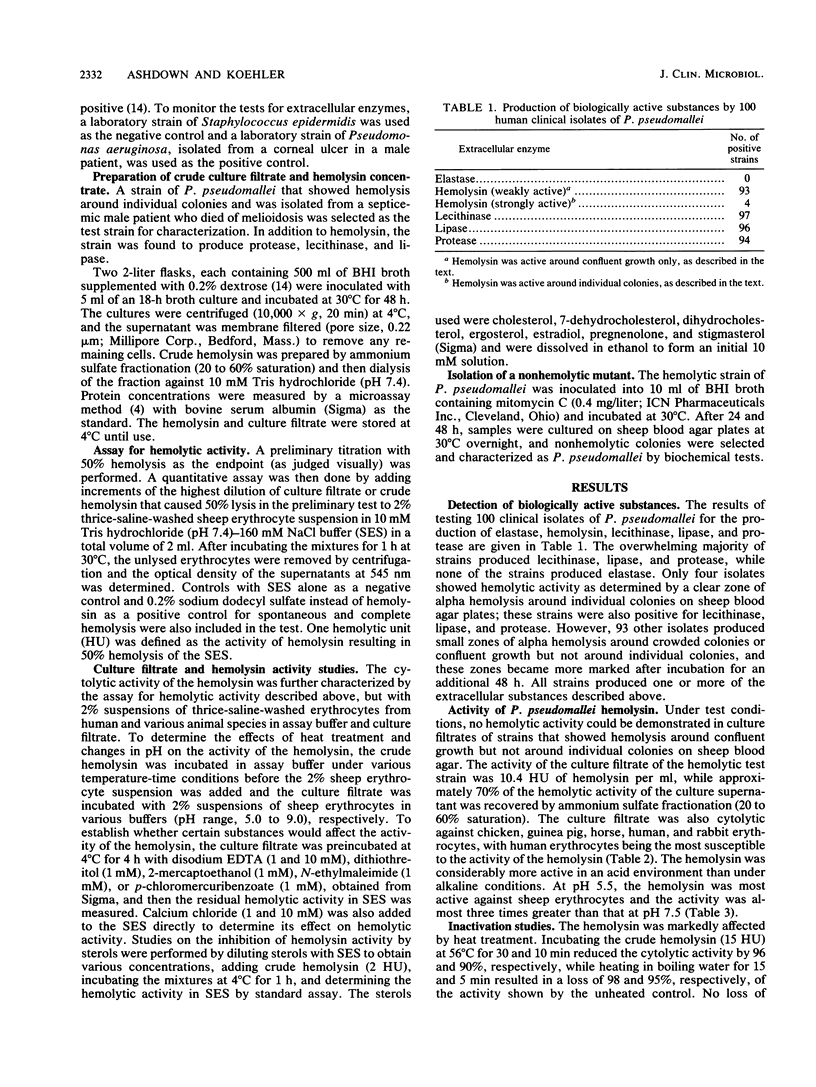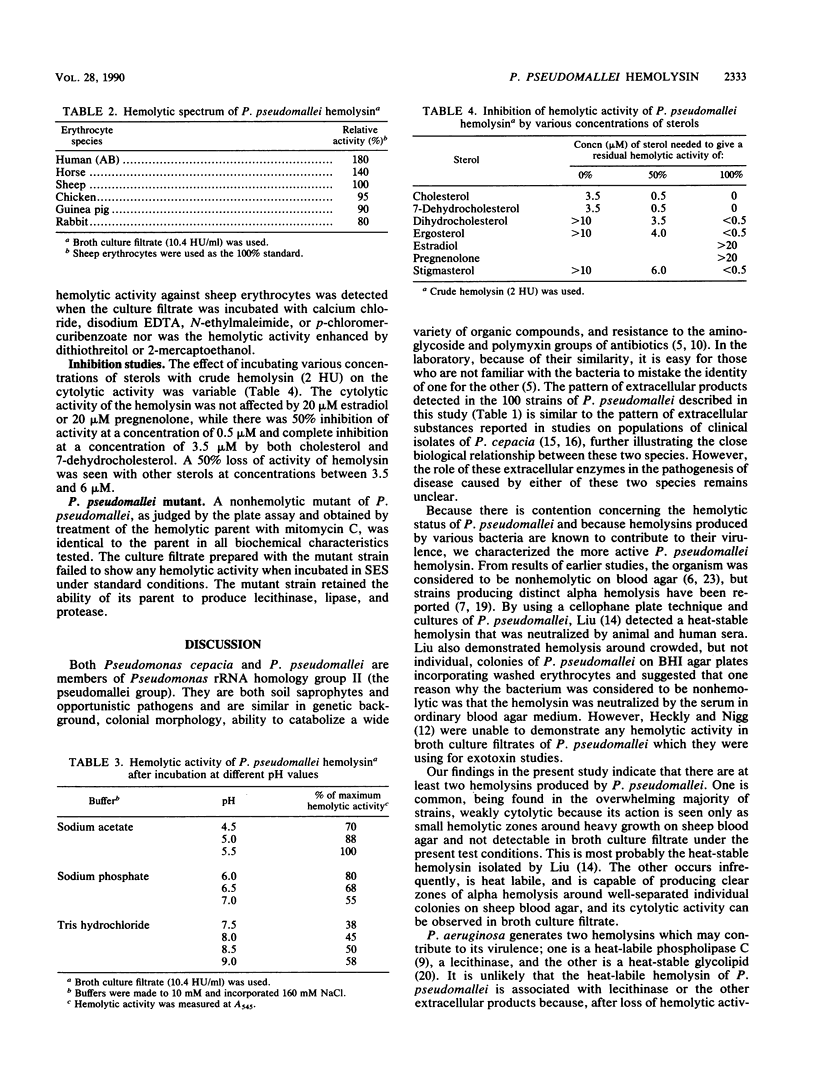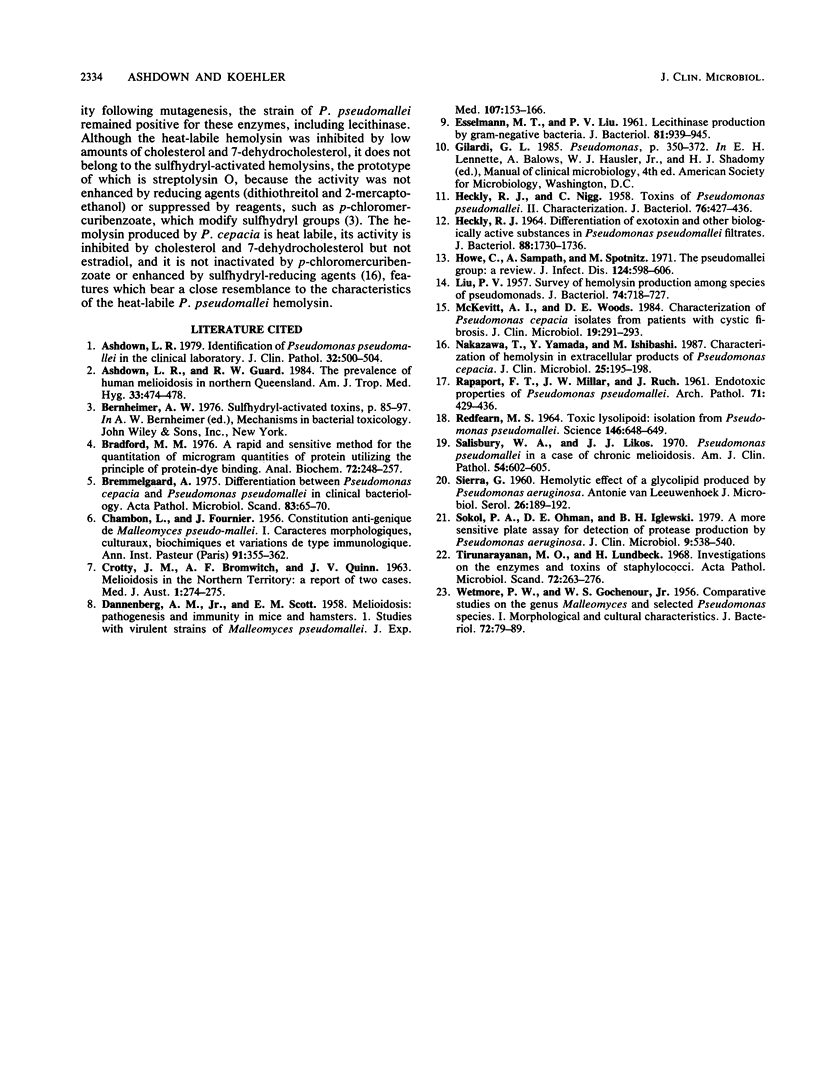Abstract
One hundred clinical isolates of Pseudomonas pseudomallei from humans were tested for their ability to produce extracellular, biologically active substances which are thought to contribute to the virulence of Pseudomonas species. All isolates produced at least on extracellular enzyme; 91 strains were positive for lecithinase, lipase, and protease; but none was positive for elastase. Ninety-three strains produced a hemolysin which was detectable around the heavy growth on saline-washed sheep erythrocyte brain heart infusion agar but not demonstrable around individual colonies or in broth culture filtrate. In contrast, a hemolysin which was cytolytic around individual colonies of P. pseudomallei on the assay plate and in broth culture filtrate was exhibited by four strains. By using one of these four isolates as the test strain, the latter hemolysin was characterized further. It was heat labile, most active in an acid environment (pH 5.5), and cytolytic in broth culture filtrate for a variety of animal and human erythrocytes. Sterols, particularly cholesterol and 7-dehydrocholesterol, inhibited its hemolytic activity, but the activity was not enhanced by reducing agents or suppressed by reagents which modify sulfhydryl-activated hemolysins. A nonhemolytic mutant of the test strain of P. pseudomallei retained the extracellular enzymes of its parent, indicating that the hemolysin was not a lecithinase, lipase, or protease.
Full text
PDF



Selected References
These references are in PubMed. This may not be the complete list of references from this article.
- Ashdown L. R., Guard R. W. The prevalence of human melioidosis in Northern Queensland. Am J Trop Med Hyg. 1984 May;33(3):474–478. doi: 10.4269/ajtmh.1984.33.474. [DOI] [PubMed] [Google Scholar]
- Ashdown L. R. Identification of Pseudomonas pseudomallei in the clinical laboratory. J Clin Pathol. 1979 May;32(5):500–504. doi: 10.1136/jcp.32.5.500. [DOI] [PMC free article] [PubMed] [Google Scholar]
- Bradford M. M. A rapid and sensitive method for the quantitation of microgram quantities of protein utilizing the principle of protein-dye binding. Anal Biochem. 1976 May 7;72:248–254. doi: 10.1016/0003-2697(76)90527-3. [DOI] [PubMed] [Google Scholar]
- Bremmelgaard A. Differentiation between Pseudomonas cepacia and Pseudomonas pseudomallei in clinical bacteriology. Acta Pathol Microbiol Scand B. 1975 Apr;83(2):65–70. doi: 10.1111/j.1699-0463.1975.tb00073.x. [DOI] [PubMed] [Google Scholar]
- CHAMBON L., FOURNIER J. Constitution antigénique de Malleomyces pseudo-Mallei. I. Caractères morphologiques, culturaux, biochimiques et variations de type immunologique. Ann Inst Pasteur (Paris) 1956 Sep;91(3):355–362. [PubMed] [Google Scholar]
- CROTTY J. M., BROMWICH A. F., QUINN J. V., BROTHERTON J. Meliodosis in the Northern Territory: a report of two cases. Med J Aust. 1963 Feb 23;50(1):274–275. [PubMed] [Google Scholar]
- DANNENBERG A. M., Jr, SCOTT E. M. Melioidosis: pathogenesis and immunity in mice and hamsters. I. Studies with virulent strains of Malleomyces pseudomallei. J Exp Med. 1958 Jan 1;107(1):153–166. doi: 10.1084/jem.107.1.153. [DOI] [PMC free article] [PubMed] [Google Scholar]
- ESSELMANN M. T., LIU P. V. Lecithinase production by gramnegative bacteria. J Bacteriol. 1961 Jun;81:939–945. doi: 10.1128/jb.81.6.939-945.1961. [DOI] [PMC free article] [PubMed] [Google Scholar]
- HECKLY R. J. DIFFERENTIATION OF EXOTOXIN AND OTHER BIOLOGICALLY ACTIVE SUBSTANCES IN PSEUDOMONAS PSEUDOMALLEI FILTRATES. J Bacteriol. 1964 Dec;88:1730–1736. doi: 10.1128/jb.88.6.1730-1736.1964. [DOI] [PMC free article] [PubMed] [Google Scholar]
- HECKLY R. J., NIGG C. Toxins of Pseudomonas pseudomallei. II. Characterization. J Bacteriol. 1958 Oct;76(4):427–436. doi: 10.1128/jb.76.4.427-436.1958. [DOI] [PMC free article] [PubMed] [Google Scholar]
- Howe C., Sampath A., Spotnitz M. The pseudomallei group: a review. J Infect Dis. 1971 Dec;124(6):598–606. doi: 10.1093/infdis/124.6.598. [DOI] [PubMed] [Google Scholar]
- LIU P. V. Survey of hemolysin production among species of pseudomonads. J Bacteriol. 1957 Dec;74(6):718–727. doi: 10.1128/jb.74.6.718-727.1957. [DOI] [PMC free article] [PubMed] [Google Scholar]
- McKevitt A. I., Woods D. E. Characterization of Pseudomonas cepacia isolates from patients with cystic fibrosis. J Clin Microbiol. 1984 Feb;19(2):291–293. doi: 10.1128/jcm.19.2.291-293.1984. [DOI] [PMC free article] [PubMed] [Google Scholar]
- Nakazawa T., Yamada Y., Ishibashi M. Characterization of hemolysin in extracellular products of Pseudomonas cepacia. J Clin Microbiol. 1987 Feb;25(2):195–198. doi: 10.1128/jcm.25.2.195-198.1987. [DOI] [PMC free article] [PubMed] [Google Scholar]
- RAPAPORT F. T., MILLAR J. W., RUCH J. Endotoxic properties of Pseudomonas pseudomallei. Arch Pathol. 1961 Apr;71:429–436. [PubMed] [Google Scholar]
- REDFEARN M. S. TOXIC LYSOLIPOID: ISOLATION FROM PSEUDOMONAS PSEUDOMALLEI. Science. 1964 Oct 30;146(3644):648–649. doi: 10.1126/science.146.3644.648. [DOI] [PubMed] [Google Scholar]
- SIERRA G. Hemolytic effect of a glycolipid produced by Pseudomonas aeruginosa. Antonie Van Leeuwenhoek. 1960;26:189–192. doi: 10.1007/BF02539004. [DOI] [PubMed] [Google Scholar]
- Salisbury W. A., Likos J. J. Pseudomonas pseudomallei in a case of chronic melioidosis. Am J Clin Pathol. 1970 Oct;54(4):602–606. doi: 10.1093/ajcp/54.4.602. [DOI] [PubMed] [Google Scholar]
- Sokol P. A., Ohman D. E., Iglewski B. H. A more sensitive plate assay for detection of protease production by Pseudomanas aeruginosa. J Clin Microbiol. 1979 Apr;9(4):538–540. doi: 10.1128/jcm.9.4.538-540.1979. [DOI] [PMC free article] [PubMed] [Google Scholar]
- Tirunarayanan M. O., Lundbeck H. Investigations on the enzymes and toxins of staphylococci. Assay of lipase using Tween as the substrate. Acta Pathol Microbiol Scand. 1968;72(2):263–276. doi: 10.1111/j.1699-0463.1968.tb01342.x. [DOI] [PubMed] [Google Scholar]
- WETMORE P. W., GOCHENOUR W. S., Jr Comparative studies of the genus Malleomyces and selected Pseudomonas species. I. Morphological and cultural characteristics. J Bacteriol. 1956 Jul;72(1):79–89. doi: 10.1128/jb.72.1.79-89.1956. [DOI] [PMC free article] [PubMed] [Google Scholar]


